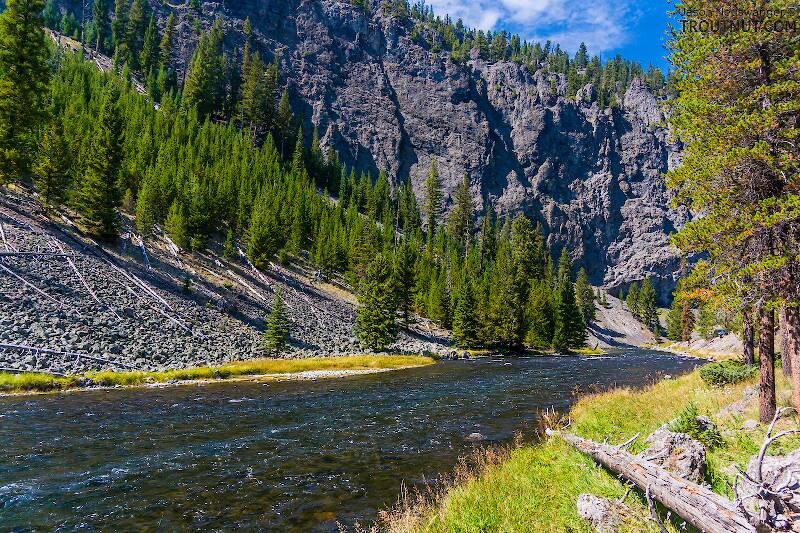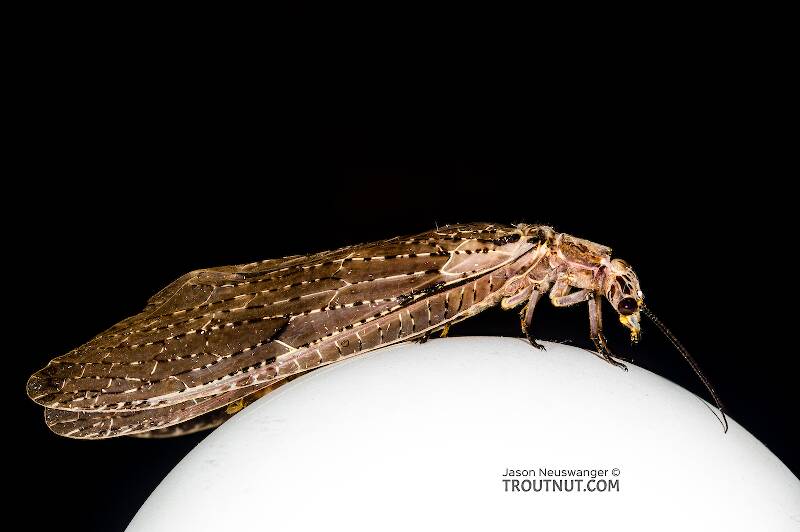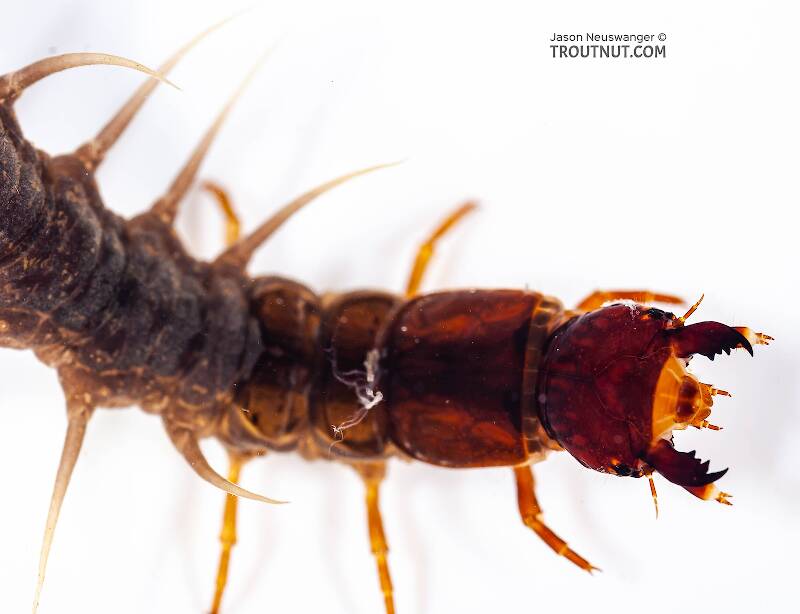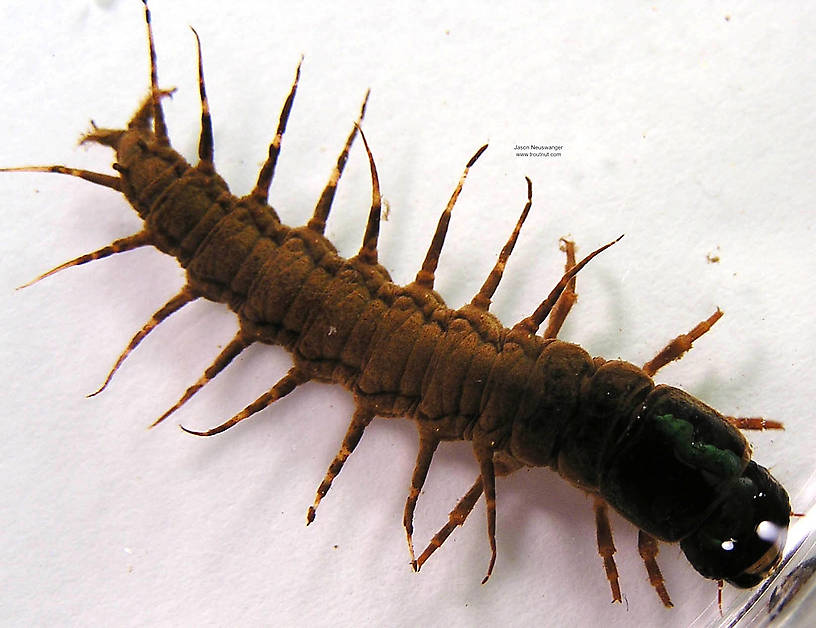
Hex Mayflies
Hexagenia limbata
The famous nocturnal Hex hatch of the Midwest (and a few other lucky locations) stirs to the surface mythically large brown trout that only touch streamers for the rest of the year.
Featured on the forum

Nymphs of this species were fairly common in late-winter kick net samples from the upper Yakima River. Although I could not find a key to species of Zapada nymphs, a revision of the Nemouridae family by Baumann (1975) includes the following helpful sentence: "2 cervical gills on each side of midline, 1 arising inside and 1 outside of lateral cervical sclerites, usually single and elongate, sometimes constricted but with 3 or 4 branches arising beyond gill base in Zapada cinctipes." This specimen clearly has the branches and is within the range of that species.

Troutnut is a project started in 2003 by salmonid ecologist Jason "Troutnut" Neuswanger to help anglers and
fly tyers unabashedly embrace the entomological side of the sport. Learn more about Troutnut or
support the project for an enhanced experience here.
This topic is about the Insect Family Corydalidae
Hellgrammites are the vicious larvae of the Dobsonflies, some of the only trout stream insects which pose a biting threat to the angler. The pincers of the adult are even more frightening that the larva's, and they're aggressive enough to use them once in a while.This family's life cycle does not create good dry fly opportunities, but the larvae may be eaten by trout year-round. They are a secret told only by stomach samples of well-fed trout.
Example specimens
Raider83 on Jun 27, 2008June 27th, 2008, 6:21 am EDT
I am an amatuer entomologist and am searching for adult dobsonflies. I think this is the right time of year for dobsonflies in Indiana. what are some ideal places and times to look? I know they like lights. If anyone lives in Indiana what are good places to look? I know you guys know your stuff when it comes to aquatic insect hatches, so I thought I would ask. TIA
GONZO on Jun 27, 2008June 27th, 2008, 10:56 am EDT
I would look for lights near a fairly fast, rocky stretch of a low elevation river. (A gas station would be good.) In addition, Dobsonflies like to lay their eggs in the leaves of overhanging trees, on bridge abutments, or on vertical rock walls--places where the hatching larvae can fall into the water. However, these spots make for trickier collecting, especially after dark. Good hunting.
Creno on Jun 27, 2008June 27th, 2008, 2:42 pm EDT
And they often land in the bushes next to the light, not on the brightest part. Put your back to the light and look at the overhanging bushes and the ground. If you have an power inverter drive to a crick access where there are no other lights but a good view of the crick (the boat launch) and take a large 110 bulb, I use a mercury vapor, and hang it in a tree by the crick. If you hang a sheet a couple feet from the bulb so the bulb is between the crick and the sheet you will be overwhelmed with critters. And remember to look behind the sheet.
Konchu on Jun 28, 2008June 28th, 2008, 2:29 am EDT
I've collected most of mine from around security lights of light-colored buildings that are located near suitable larval habitat.
The mv light and sheet is a good idea. Not only should you check behind the sheet, but you need to check the ground and brush several feet away from the sheet. Not everything comes directly to the light.
The mv light and sheet is a good idea. Not only should you check behind the sheet, but you need to check the ground and brush several feet away from the sheet. Not everything comes directly to the light.
Konchu on Jun 30, 2008June 30th, 2008, 6:59 am EDT
I went to one of my adult Megaloptera collecting spots last Saturday (June 28), and sure enough, I found one flying around, about 4:30 Daylight Time. I don't know what about this spot is good for the adults, but I find them there frequently. It is an old church cemetery, about 1/2 mile from the nearest stream of any size.
Majj25 on Jul 1, 2008July 1st, 2008, 12:48 pm EDT
i have an adult dobson fly. slighty larger than 4 inches, with its pinchers ( or whatever they are called) at least an inch in length. id be more than happy to send it to you. im not sure if you want it alive though. its alive now. but if it dies i could package it and send it to you. not really sure how id do that. maybe you would know? i just happened to find this in my gazebo, naturally freaked out because ive never seen anything like it before.researched it and found this site. seattle2679@yahoo.com maggie
Raider83 on Jul 2, 2008July 2nd, 2008, 12:34 pm EDT
Maggie If you really want to send it to me(Dead) then go ahead and try. Packaging wise, I would put in a small plastic container that it fits in and gently surround it with cotton balls to protect it. It will most likely break somehow, but its worth a shot if you still have it. If it flew away, thanks anyway for your generous offer.
Shawnny3 on Jul 3, 2008July 3rd, 2008, 6:38 am EDT
Nah, have some fun with the postman and send it alive. I'm thinking a transparent container with air holes punched in it.
-Shawn
-Shawn
Jewelry-Quality Artistic Salmon Flies, by Shawn Davis
www.davisflydesigns.com
www.davisflydesigns.com
Quick Reply
Related Discussions
Topic
Replies
Last Reply
2
Jul 22, 2007
by GONZO
by GONZO
Re: I got the scope Jason recommended and here are some pics through it!
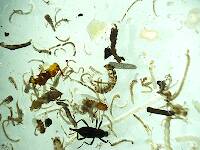
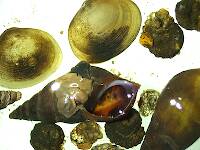
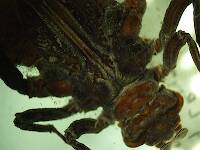
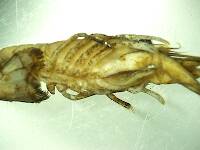
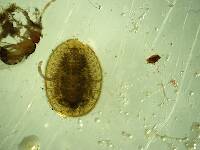
In the Photography Board by Jmd123





In the Photography Board by Jmd123
5
Dec 1, 2020
by Creno
by Creno

